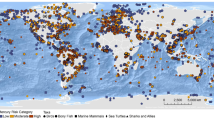Abstract
Principles, advantages, and limitations of the use of radiotracer method for the analysis of speciation and migration of contaminants in the environment are briefly discussed. Several recent examples of use in the author's laboratory are given: development of the separation method for methylmercury and inorganic mercury in hair, analysis of the speciation of cadmium in soil solutions, study of the interaction of137Cs and58Co with suspended sediments in river water, and determination of input data for mathematical modeling of radiocesium migration in a small river.
Similar content being viewed by others
References
M. Bernhard, F. E. Brinckman, and P. J. Sadler, eds.The Importance of Chemical “Speciation” in Environmental Processes, Springer Verlag, Berlin, 1986.
J. R. Kramer and H. A. Allen, eds.,Metal Speciation, Theory, Analysis and Application, Lewis, 1988.
G. A. Batley, ed.,Trace Element Speciation: Analytical Methods and Problems, CRC Press, Boca Raton, FL, 1989.
W. Salomons and U. Foerstner,Metals in the Hydrocycle, Springer Verlag, Berlin, 1984.
P. Beneš, inThe Environmental Behaviour of Radium, vol. 1, International Atomic Energy Agency, Vienna, 1990, pp. 273–299.
P. Beneš and V. Majer,Trace Chemistry of Aqueous Solutions, Elsevier, Amsterdam, 1980.
H. J. M. Bowen, E. Page, I. Valente, and R. J. Wade,J. Radioanal. Nucl. Chem. 48, 9 (1979).
M. Amdurer, D. Adler, and P. H. Santschi, inTrace Metals in Sea Water, C. S. Wong, ed., Plenum New York, 1983, pp. 537–562.
H. A. Das, A. Faanhof, and H. A. van der Sloot,Radioanalysis in Geochemistry, Elsevier, Amsterdam, 1989.
K. Kratzer, P. Beneš, and V. Spěváčková, Separation of methyl-mercury from human hair by solvent extraction,Int. J. Environ. Anal. Chem., in press.
K. Kratzer, D. Kolihová, P. Beneš, V. Spěváčková, and J. Žilková,J. Anal. At. Spectrom. 9, 303 (1994).
P. Podhájecký, A. Gosman, and P. Beneš,J. Radioanal. Chem. 57, 253 (1980).
P. Beneš and J. Glos,J. Radioanal. Chem. 52, 43 (1979).
P. Beneš and E. Steinnes,Int. J. Environ. Anal. Chem. 4, 263 (1976).
P. Beneš and M. Obdržálek, inProc. Sem. Hydrochémia 80, Water Research Institute, Bratislava, 1980, pp. 139–156.
J. Mizera, Diploma Thesis, Czech Technical University, Prague, 1993.
P. Beneš and L. Loub, unpublished results.
M. Piro, M. Bernhard, M. Branica, and M. Verzi, inRadioactive Contamination of the Marine Environment, International Atomic Energy Agency, Vienna, 1973, pp. 29–44.
P. Beneš et al.,J. Radioanal. Nucl. Chem., Articles 132, 209, 225 (1989)133, 359 (1989), and159, 201 (1992).
P. Beneš, P. Picat, M. Černík and J. M. Quinault,J. Radional. Nucl. Chem., Articles 159, 175 (1992).
P. Beneš and M. Černík,J. Radioanal. Nucl. Chem., Articles 159, 187 (1992).
P. Beneš, M. Černík, and O. Slávik,J. Environ. Radioact. 22, 279 (1994).
Author information
Authors and Affiliations
Rights and permissions
About this article
Cite this article
Beneš, P. Radiotracer method in the study of environmental speciation and migration of contaminants. Biol Trace Elem Res 43, 79–85 (1994). https://doi.org/10.1007/BF02917302
Issue Date:
DOI: https://doi.org/10.1007/BF02917302




